In fall 2018, there were nearly seven million students enrolled in distance learning courses.
And that number is only going to rise in 2020.
The University of Texas at Austin, for example, is set to offer about 20% of all courses online this fall.
As online programs grow in importance, it’s crucial that faculty have the tools and guidance they need to create quality online course videos.
With the right strategies, however, you can interact with online students, pay attention to their questions, and give personalized feedback, all while measuring participation and comprehension.
If you follow these seven strategies, you can easily build a great online course!
Below are first-hand experiences plus tips and techniques from faculty on how they ensure that they are empowered to create online course content that engages students.
1. Integrate video creation and sharing with your LMS
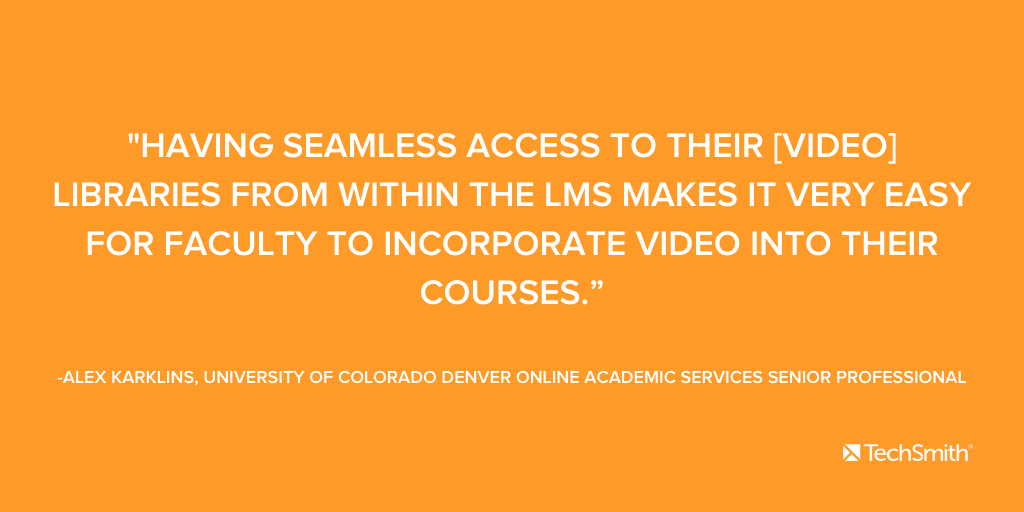
One of the keys to training faculty to create quality online course videos is to start with a video platform that is easy to use.
If at all possible, make it a priority to choose a video platform that integrates seamlessly with your Learning Management System, or LMS. Being able to create and view videos within the system that faculty already use is one of the single biggest things you can do to increase faculty adoption.
At the University of Colorado Denver, administrators rolled out a new video platform, but didn’t immediately ‘turn on’ the LMS integration. Before the integration, their staff spent a lot of time training faculty how to use the systems together.
Creating and sharing lecture videos wasn’t as easy as it should have been, and often infringed on faculty’s already-packed schedules. Administrators knew they needed to try a different approach to make it easier to create and share videos without adding more overhead to the workflow.
Once they turned on the integration, including single sign-on, they quickly started to see broad adoption. Alex Karklins, CU Online Academic Services Senior Professional, explains the faculty impact of integrating their video platform with the LMS: “It wasn’t until we installed the LTI integration into all of our Canvas courses that faculty usage really took off.”
With single sign-on and a simpler process for video creation and sharing, administrators noticed smoother onboarding, fewer refresher training sessions, and significantly more usage by faculty. Instructors were able to use their own existing laptops and computers to record from any classroom, and they could control their ‘start’ and ‘stop’ times.
Ease of use made a huge difference.
“Having seamless access to their libraries from within the LMS makes it very easy for faculty to incorporate video into their courses.” After the integration, even hesitant faculty were creating and sharing videos with their students in both online and blended courses.
2. Create videos for online courses
With the right strategies, instructors can interact with online students, pay attention to their questions, and give personalized feedback, all while measuring participation and comprehension.
Here are seven videos to include in any online course:
1. Intro video
2. Course navigation video
3. New week, topic, or unit video
4. Walkthrough videos
5. Assignment and project feedback videos
6. Student-created videos
7. Concise video lessons
3. Encourage faculty to create accessible course materials
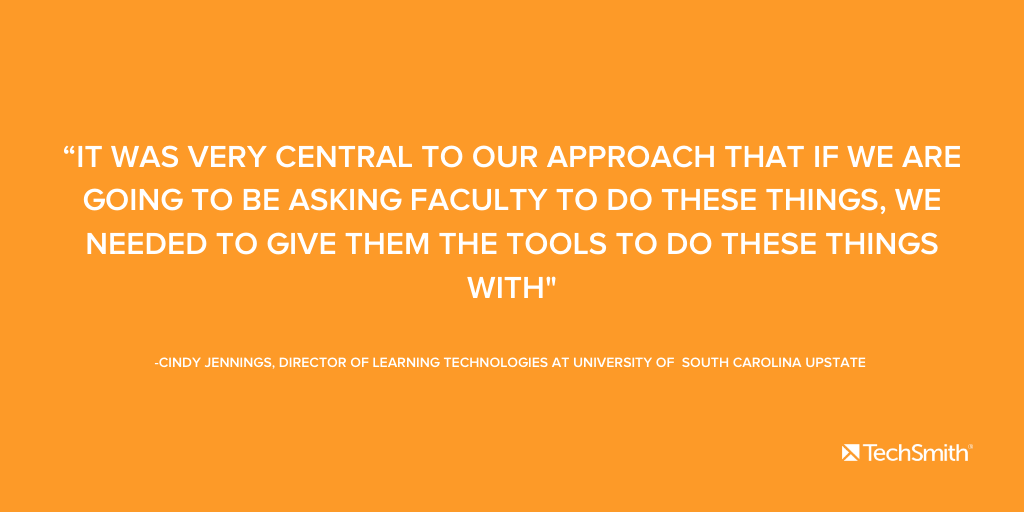
In their fourth year with an accessibility awareness committee, the University of South Carolina Upstate had a significant challenge – to make sure all of the user community is educated about the need for captions, and to encourage faculty to generate them when they create recordings.
As part of a five-year-plan to ensure accessibility, they realized it’s a lot to ask of faculty, who already have a lot on their plates. So far, they’ve found the most success by emphasizing the benefits of inclusive design strategies instead of simply meeting the legal requirements.
Emphasize advantages, not authority
“We approach it from the perspective of accessibility assurance,” said Cindy Jennings, Director of Learning Technologies. “We very rarely talk about legislation or compliance. Sometimes we have folks who want to know why [we require captions], and occasionally we’ll pull out the ‘ADA hammer’, but we try to stay away from that as much as possible.”
Very quickly, they realized the right accessibility tools can make all the difference in whether faculty can fit into their already-busy schedules.
Ease of use is key
“It was very central to our approach that if we are going to be asking faculty to do these things, we needed to give them the tools to do these things with,” explained Cindy. “We were really looking for the ability to have automated, integrated captioning that was easy and helpful for faculty and fairly low-threshold to adopt as their standard practice, not as an add-on. The rollout of TechSmith Knowmia last fall was very much a driver of that whole strategy. We have excellent adoption of Knowmia, better than we ever dreamed of the solution itself.”
Due to feedback from faculty that captioning can be time-consuming, the committee suggests ways to yield the most accurate captions at the first pass, including:
- Record quality audio. Choose a quiet place to record course videos. Shut windows and doors, turn off background music, and avoid any nearby air conditioner that might kick on halfway through. Although a built-in laptop microphone is fine, even an inexpensive USB mic goes a long way to improve audio quality.
- Speak slowly and clearly. Doing this lets the caption engine recognize your words and phrase patterns. More accurate captions at the first pass results in less caption editing later. If humans are captioning videos, speaking clearly helps them understand what you’re saying.
- Create shorter, focused videos. Best practices for online course videos show that shorter videos not only help get the course material across, they also make captioning easier. “We’re still in the throes of educating faculty about shorter, more frequent videos, as opposed to recording two-hour-long lessons,” said Cindy. “We show them how shorter videos are better for your students. It’s easier for students’ overall cognitive load, and makes it easier for faculty to edit captions.”
Along with holding departmental training sessions, the committee also developed a group called Access Advocates. It’s one extra layer of assurance that each department has someone identified to be a communication channel and assist others if they have a question.
Faculty are finding new ways to use video in their courses, explains Cindy. “Now, we’re beginning to have faculty request how they can utilize the Knowmia recorder for students to record and do multimedia projects in the system,” which opens up new opportunities for student-centered learning and multimedia expression.
4. Get data to share effective online teaching practices
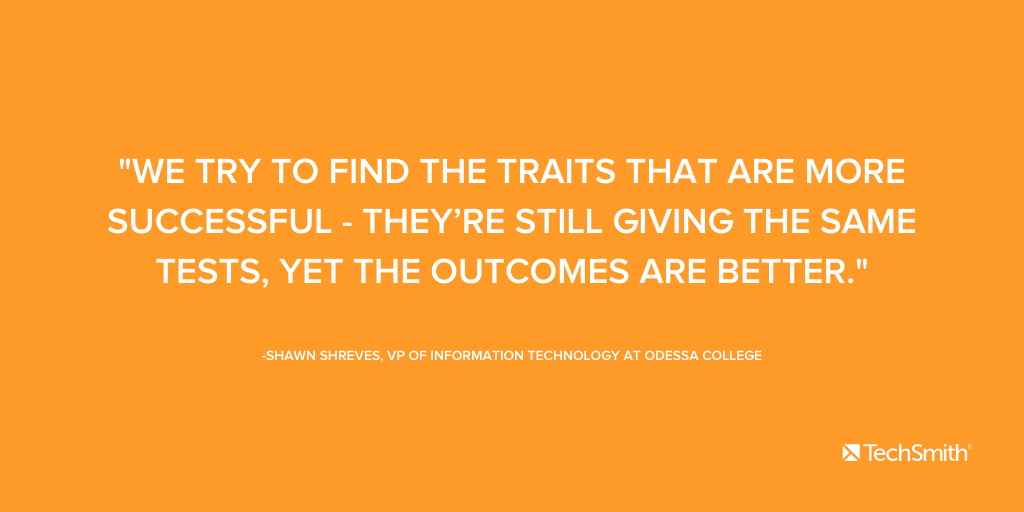
Winner of an Aspen Prize Rising Star Award based on student engagement, retention, and performance, administrators at Odessa College carefully monitor success rates, but not just of students. They monitor success rates of faculty as well.
Young, dual-enrolled demographic
Low regional unemployment is a good thing overall; however, in this region, it can present a challenge for community colleges. As the price of oil goes up, enrollment tends to go down since there are plentiful, high-paying jobs in the oil fields. Due in part to this, dual credit enrollment is a growing trend, with about one-third of students at Odessa still in high school.
Set up for success
It can be challenging to serve such a diverse community in age, from fifteen years old up to seventy years old. The youngest generation may be in classes with just high schoolers, or they may be in a mixed class of all ages. Successful engagement strategies are more important than ever, especially in online programs.
Rich stores of valuable data
With data driving the project, Odessa carefully tracked course pass rates. After analyzing a large amount of data, they soon uncovered retention patterns. For example, while eight or ten biology instructors may all teach the same course across different time slots, some have a higher success rate than others. Success rate is defined as students getting a ‘C’ or better in the course.
Shawn Shreves, VP of Information Technology, explains the discovery process: “We try to find the traits that are more successful – they’re still giving the same tests, yet the outcomes are better. We talk to faculty who have high success rates and ask ‘How are you engaging the students?’ vs instructors who have lower engagement and lower success rates. Based on that, we try to coach them up. We say, ‘Here’s what the successful teachers are doing,’ and we share those strategies across the entire college.”
Based on success with that process, administrators use the latest analytics to pull data from their LMS and their TechSmith Knowmia video platform to see what students are doing online – how many course videos they’re watching, how often they’re watching, and more.
“We see a lot more of our students are used to learning through videos,” explained Shawn. “It’s part of being in that generation, like my teenage sons at home growing up with video programs like Snapchat. They’re not just photo-based, it includes video. For the next generation – whatever they’re going to be called – video is very engaging to them. We’re going to try to leverage that mindset.”
Their high-engagement strategies include creating and sharing videos with TechSmith Knowmia not just for core course content, but to establish a personal presence with students. They highly encourage all faculty to:
- Create an introduction video, where instructors introduce themselves to their class and share a little bit about themselves. “The students see them as a person and it helps develop those personal relationships. Some faculty even require the students – especially if it’s a fully online course – to do so as well.” Knowmia’s administrators also recommend creating a course navigation video, lab and demo videos, and to record shorter, more focused core lecture videos by topic.
- Get to know students by name. Taking the time to learn students’ names, interests, and personalities goes a long way to helping them feel engaged in the course. Knowing that their instructor cares enough to check in with them before a quiz to see if they need help, or notice when they struggle, makes a huge difference in whether or not they fully commit to a course online.
- Measure learning with quizzes and analytics. Add Knowmia’s quizzes at key points within course videos to measure participation and gauge how students are learning the material. Knowmia’s analytics let faculty see which students are watching videos, which are struggling, and when they need help.
Overall, administrators continue to see results and highly encourage faculty to use every digital tool, including Knowmia. “I would have killed for Knowmia years ago when I was teaching,” said Shawn.
5. Engage the reluctant online learner
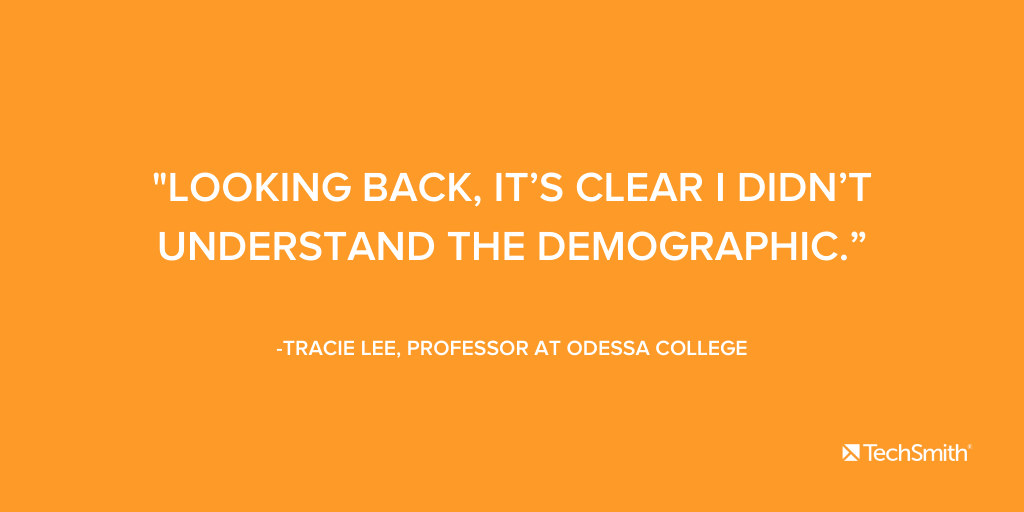
After ten years of teaching online and face-to-face classes, Tracie Lee hit a trifecta of hurdles – teaching online Introductory Business Statistics. As is common with many intro courses, students resisted taking it on general principle because it’s a mandatory course (and therefore considered dull) for all business majors, and similar enough to math to be considered difficult by entering students.
Combined with challenges inherent in online-only teaching, this course is a particular challenge. Despite following a previously-successful online model of longer video lessons along with grade points based on exams, assignments, discussions, and projects, students just weren’t learning. By midterms, fifty percent of the class was failing. “Looking back,” confessed Tracie, “it’s clear I didn’t understand the demographic.”
Tracie adjusted her approach to include much more video interaction. Specifically, she recorded video walkthroughs to show students how to think through and solve the problems. By the end of the semester, most of the remaining students passed the course. But Tracie knew it could be much better.
For the next semester, Tracie gave students more chances to practice the problems before exams. She added forty-minute video lessons, video walkthroughs, graded quizzes, and additional online discussions. Still, it wasn’t enough – students struggled.
Many weren’t watching the videos and avoided assignments until the last minute.
Coupled with unsustainable video maintenance and storage issues, Tracie knew there had to be a better approach.
Interaction tactics make all the difference
Access to the next-generation, cloud-based video platform TechSmith Knowmia provided Tracie the missing component. Now, she could measure (and require!) participation.
From the makers of Camtasia, Knowmia let Tracie easily:
- Record shorter videos. “It was shocking to me to see the statistics on the ideal video length,” Tracie explained.” There are some concepts in statistics that have too many steps to go through in five minutes. Ten minutes was a nice compromise between my original forty minute videos and the ideal three-minute attention span.”
- Embed graded quiz questions at key points within her videos. To maximize the attention span window, Tracie purposefully engages students frequently. “I try to add a quiz an average of every two minutes,” said Tracie. Now, she could measure learning as students went along, instead of just at the end of each week. At the same time, the quizzes ensure students are watching and paying attention to the entire length of videos.
- Report quiz results directly to the LMS gradebook. This makes the process easier for everyone.
- Measure participation online: for each student, and her class as a whole. “I couldn’t get students to watch videos until I made them worth points,” said Tracie. Measuring participation made a huge difference in getting students to watch attentively.
Bolstered by these new capabilities, Tracie re-recorded the older, longer videos into concise, 10-minute video lessons and added quiz questions throughout. She also began hand-writing key points on her presentation slides (as opposed to just displaying text on the screen). Tracie used an inexpensive graphics tablet with a stylus, then recorded her screen with Camtasia, and the writing showed up on the video.
The tactics worked. She quickly began to see that the students watching the videos did very well. For the future, she plans to continue embedding graded quiz questions into short videos, hand-writing more phrases, and consider reworking videos that analytics shows are not resonating with students.
Using these strategies, Tracie saw higher pass rates, lower fail rates, and lower drop rates in her fully-online course.
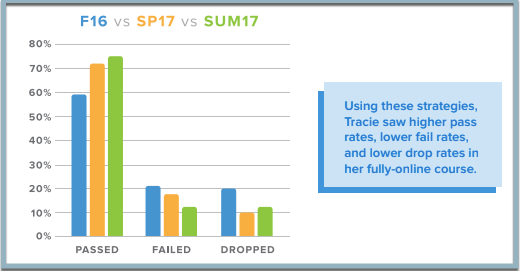
“I’ve recorded videos several times trying to figure out the best way to explain something. It forces you to be extremely focused.” Based on how students are learning, Tracie adjusts the material. “Especially when students are asking the same question over and over again, that’s really a good sign to say ‘I need to add something here.’ Sometimes that’s an extra two-minute video that I send out to the class, or sometimes I re-record the lecture instead.”
She plans to keep making improvements to achieve an 80% pass rate.
This material is shortened from Tracie Lee’s webinar “Engaging the Reluctant Learner”.
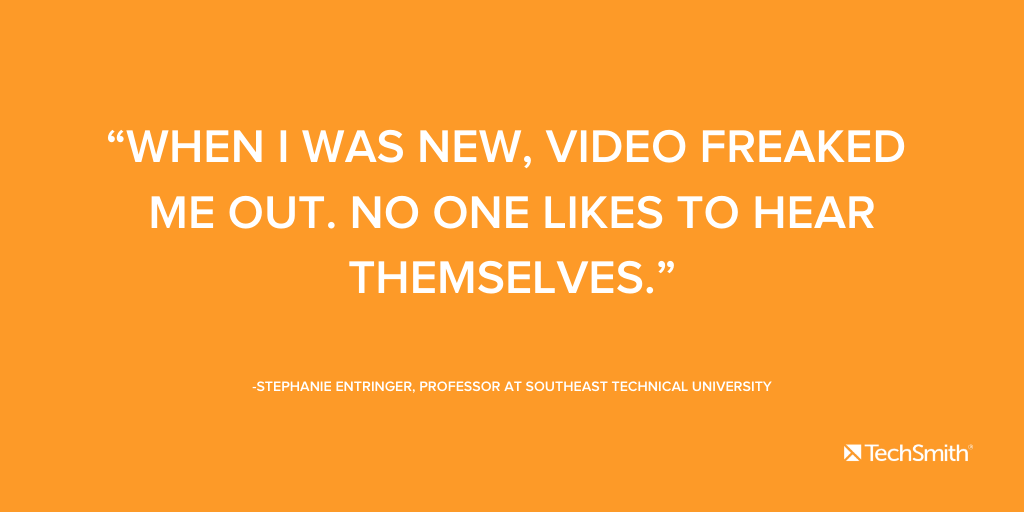
6. Encourage reluctant faculty to create quality course videos
Training faculty to create quality online courses can be challenging. It can involve overcoming barriers in technology, workflow, student-instructor relationships, and mindset. Here are some tactics from other colleges on how they encourage faculty to begin creating course videos.
Getting comfortable with their own voice
Not being comfortable with their own voice is a common complaint you may hear while training faculty to create quality online course videos. When Stephanie Entringer began recording videos at Southeast Technical University, she was hesitant. “When I was new, video freaked me out. No one likes to hear themselves.”
Soon, she realized that her voice helps build a unique relationship with her online students, and any perceived imperfections weren’t anything to worry about. “We’re all human. It doesn’t have to be perfect.” Encourage them to not only accept their voice, but let their personality shine as they build quality online course content.
Employ your rock stars
Have some rock star instructors? Faculty who have been creating videos for a long time can sometimes be the best promoters of your new software system. Encourage them to contribute a few video tips and mentor other faculty to create their first videos.
When they’re scared
Some instructors, especially those who tend to struggle with learning new technology systems, feel more comfortable asking questions in person. Administrators at Odessa Colleges also offer personalized training sessions as a final approach to onboarding.
“These sessions are usually short and focused, but the faculty seem to find them very helpful,” said Jennifer Lee, Web Design and Instructional Technology Specialist. They notice that technology confidence often plays a big part in getting these instructors on board. Once they are walked through the process and see how easy it is, they get the hang of it much more quickly.
“For many of them, once we show them how easy it is to create that first video, it boosted their confidence a great deal (and even got them excited). They started doing more and more on their own with less guidance from us.”
This is another way to get your rock-star instructors involved – encourage them to help strugglers. Often, they can answer their questions and make them feel at ease even more quickly than formal training staff.
When they just don’t want to
Some instructors philosophically resist new technology. This is usually the most challenging set to turn around; however, they are usually a small group.
Do your best to offer them all the resources you can. One-on-one training can be very useful for this group. Provide specific reasons why online courses will benefit them and their department, professionally and personally. Show examples of how other professors have created online courses as inspiration.
Remind them that instructors are the most important part of the online course – technology doesn’t replace professors; it amplifies their importance. Leif Nelson, Director of Learning Technology Solutions at Boise State University, has extensive experience onboarding and training faculty on lecture capture systems, and explains that it doesn’t always happen all at once. “There’s definitely a step approach to get people used to what’s possible with technology.”
No matter what, keep encouraging them. Sometimes the best progress happens slowly.
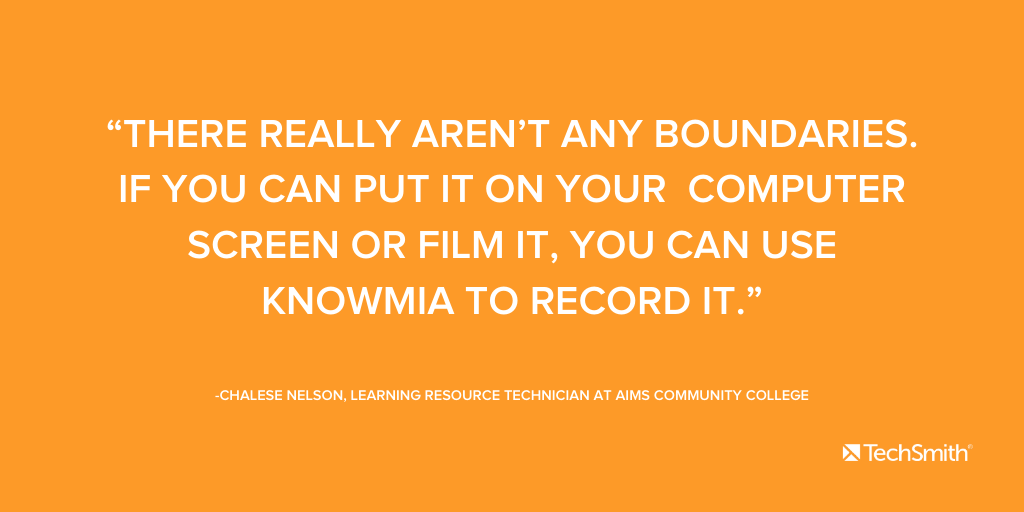
7. Create mobile videos for effective, in-the-moment instruction
Instructors at Aims Community College needed a way to create valuable, in-the-moment video lessons for students, beyond traditional lecture capture. After adopting software-based TechSmith Knowmia, faculty jumped at the chance to create engaging video lessons from any location, at any time.
Chalese Nelson, Learning Resource Technician, explains how faculty embraced having an easy way to record videos. “It’s a tool that has so many possibilities,” said Chalese. “There really aren’t any boundaries. If you can put it on your computer screen or film it, you can use Knowmia to record it.”
Recording on their smartphones was a hit, thanks to the TechSmith Fuse app that lets faculty send videos directly to Knowmia and their LMS. “Fuse is something faculty got really excited about because they record it right from their device,” said Chalese.
Especially in the health sciences, where instructors frequently demonstrate clinical skills, instructors embraced mobile video recording wholeheartedly. “The nursing program just grabbed it and ran,” Chalese explained. The EMT and Nurse Aide programs use Fuse to evaluate skills in scenario training.
Not only do instructors record phone video to show hands-on skills, they also use video to record and evaluate nursing students’ competency. “It’s been revolutionary for those students,” said Chalese. “It’s put a lot more accountability in the students’ hands because they can actually watch their skills. They’re seeing themselves. They see what they’re doing wrong, what they’re doing right, and what they need to work on before it even gets to the instructor.”
Moreover, nursing faculty told administrators that it changed the way students look at themselves and the skills that they work on. It helps significantly with them taking ownership of sharpening and improving their skills before the final evaluation. Using mobile devices to create effective online videos is also working in other departments. “Our speech teacher is saying the same thing,” said Chalese. “Students are seeing their own skills ‘live’, right now, and can adjust their performance immediately.”
Combined with Knowmia’s robust, yet simple screen recording, faculty can choose how much interaction they want to include in their video content, and make it work in their current course flow.
“You can capture another video and include that in your lesson,” said Chalese. “You can put your own spin on it, add graphics to it, put your voice on it, even interject your face [with a webcam]. It’s a great tool to share information in a variety of ways. Whether you have a video lesson or a class update, TechSmith Knowmia is robust and versatile. There are so many different things that can be done with it!”
Faculty also love the autonomy – they can use Knowmia on any computer or mobile device, and without download support from IT. “Being web-based is awesome. Being able to switch from whatever computer or device I need to without having to have a recorder downloaded is awesome. Having access to the file management system from any computer, tablet, or phone to work wherever I’m at is incredibly helpful.”
Instructors also like being able to choose how much recording they will do and when it makes sense to customize content. “Between Techsmith Knowmia, Snagit, and Camtasia, you can do anything. You can edit a picture, edit a video, upload media, and even grab educational content from YouTube.”
Ready to see online course success similar to the colleges in this blog? TechSmith Knowmia’s ease of use, accessibility, powerful analytics, and unparalleled customer service are why TechSmith is the market leader according to Frost and Sullivan and the Campus Computing Project.
Learn how TechSmith Knowmia can help increase video adoption, student engagement, and student outcomes at your institution, including migration services to help transition your existing content.



Share